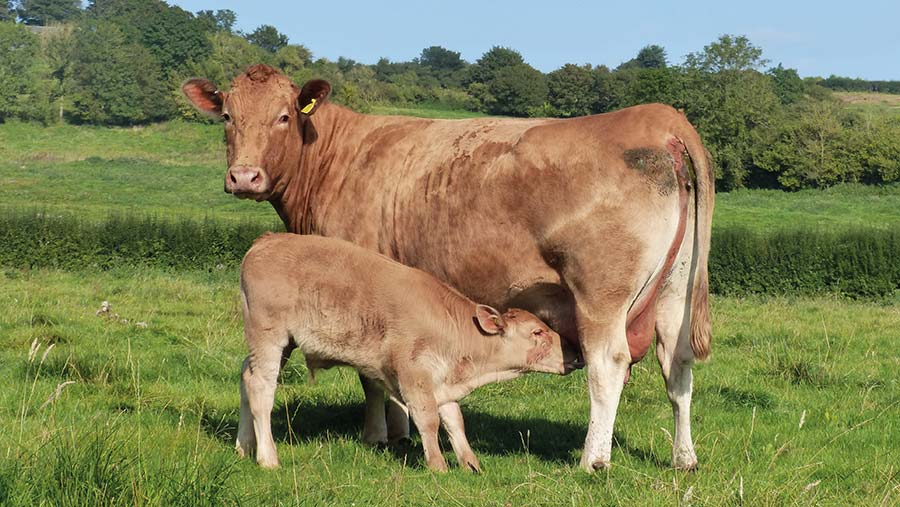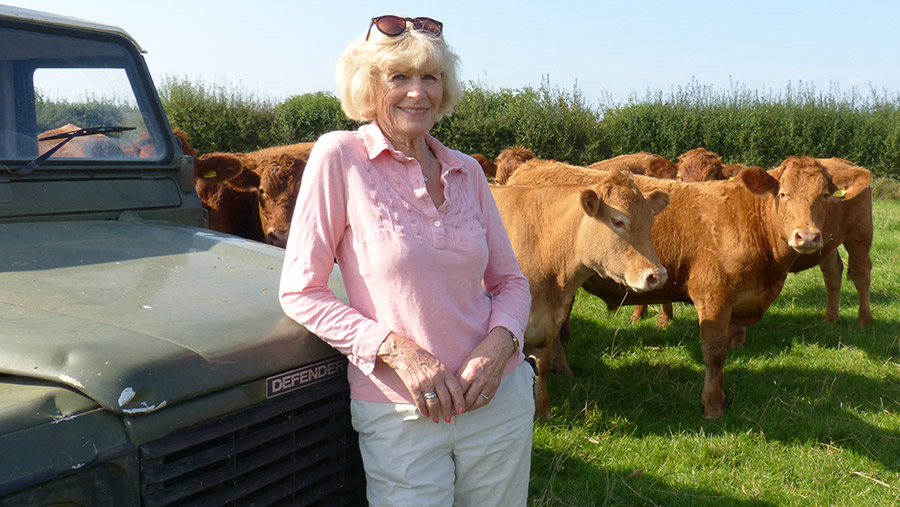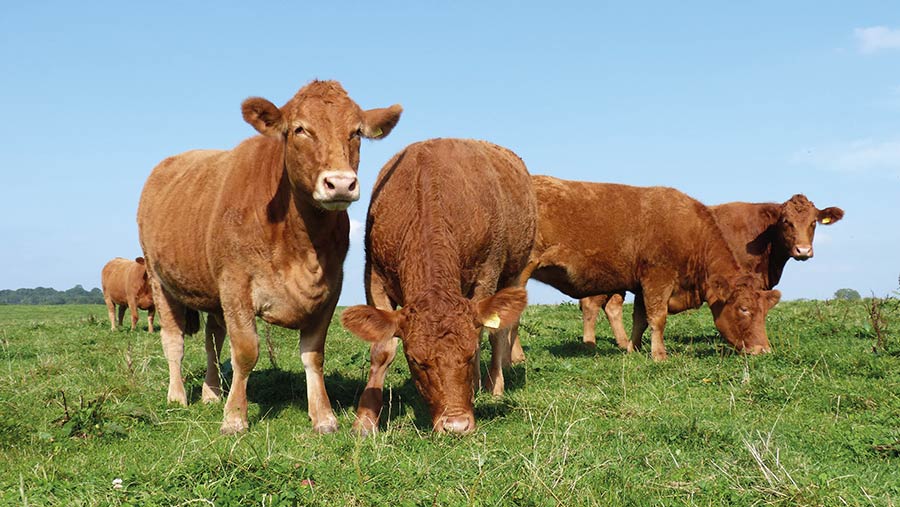How myostatin screening is improving calving on suckler farm
 © MAG/Michael Priestley
© MAG/Michael Priestley Calf output has increased on a Somerset farm after addressing calving difficulties by sourcing easy-calving bulls with a zero-myostatin status.
Historically, before becoming aware of the potential disruptive influence of the myostatin gene on cattle breeding, Charlotte Davis, of Clapton Farm, near Wincanton, would see seven to 10 calves die for every 50 cows that calved to South Devon bulls.
However, for the past six years, all the bulls bought to serve Clapton Farm’s 110 suckler cows have been selected for their zero-myostatin status (see ‘What is myostatin?’).
See also: What is pelvic scoring and how valuable is it for calving?
Since this policy was adopted, calving issues have abated, mortality is virtually non-existent, and the stress and cost of caesareans is now a rarity.
This is possible since the South Devon Herd Book Society (SDHBS) made myostatin DNA testing compulsory in 2007.
Under society rules, a bull cannot enter the herd book without a known myostatin status.
Farm facts
Clapton Farm
- 110 suckler cows on 150ha (370 acres)
- Cross-bred cows, mostly seven-eights South Devon bred to South Devon bulls
- All ground is grassland – grade four and some three
- Stores sold at 12-24 months at Salisbury market – some heifers sold for breeding
- Farm on Agricultural Holdings Act tenancy
- Spring and autumn calving
- Higher Level Stewardship scheme
- Cows, bulls and youngstock just eat grazed grass, silage and mineral supplements
Lost cows and calves
One nightmare spring included nine caesareans, three dead cows and 10 dead calves, explains Ms Davis, who has farmed at Clapton Farm since 2004, when she inherited the tenancy from her father, Jim.
And because sucklers are the only enterprise on the farm, the cows must produce live calves.
Today, only 4% of calvings require a calving jack or a pull – due to being twins, backwards or having a leg back.
What is myostatin?
- Myostatin is a gene connected with the production of proteins that regulate muscle development
- Myostatin nt821 is a genetic variant that means muscle growth is not regulated – it’s deleted or “switched off”. This can be a good thing if growth happens after birth, but can produce calving issues if growth is in-utero
- Nt821 variant is in 50% of South Devon bulls
- A lesser number of South Devon animals carry myostatin F94L, which is also seen in Limousins and is associated with muscular calves but unaffected calvings
- A South Devon animal can either carry no copies of the gene and is known as a “zero”, can be heterozygous and carry one copy, or be homozygous and carry two copies
- Myostatin NT821 has an “additive effect”, so two copies of the variant in a calf has a greater effect than one copy
Benefits of nt821
- Increase muscle conformation
- Increase carcass weight at slaughter
- Leaner carcass
Negatives of nt821
- Increases birthweight
- Makes calving more difficult
- Reduces weight gain
- Reduces organ and bone development
- Reduces eating quality
Source: Roslin Institute
Myostatin
When told by other breeders that myostatin could be the problem, Ms Davis could have screened her cows to see which zero-myostatin cows could be put to a bull with one copy of myostatin and therefore avoid calves having two copies.
However, this would have taken time and money, so she simply opted to buy zero-myostatin bulls.
A zero-myostatin bull can be identified by looking at its pedigree records, and in sales catalogues, its status is shown as “0”.
“Some of the breeders I buy from know me and knew my father, so they know my cows and what I need,” explains Ms Davis. “Having a conversation with the breeders helps.”

Charlotte Davis © MAG/Michael Priestley
Ms Davis believes she isn’t missing out on carcass and conformation by avoiding bulls with a single copy of myostatin nt821.
“I am watching very closely whether the calves lose shape or not. They haven’t yet. Live calves are the priority and I can do that without any myostatin at all.”
Ms Davis selects bulls in the following way:
- Must be zero myostatin
- Must be easy calving – she looks at estimated breeding values to check the calving performance of the bull’s dam and sire if the herd is recorded
- She selects for good early growth to 400- and 600-day weight
- Bulls must be correct with good feet, mobility and easy-fleshing characteristics
- She also discusses back breeding with the breeder.
Calving
Calves are weaned at about six weeks pre-calving at 10-11 months old. All cows are normally out by 1 April.
An autumn- and spring-calving block – both numbering about 55 cows – calve outside at grass.
Only problem cows are brought inside into a loose-housed shed, where there is a calving pen and a calving aid.
The first calving check is done at 4:30am and five more checks are made throughout the day.
If any cow is seen calving, it is monitored until calving is complete and calves are up and sucked.
Clapton Farm system
- No hard feed bought – bulls, youngstock and cows eat grass and about 64ha (160 acres) is silaged annually
- The farm is in three sections. An upper area is 40ha (90 acres) of limestone brash, then a steep bank with scrubby areas runs down to a low-lying area with heavier soils and lots of grade four land
- Minerals are supplied all year-round through boluses, as flakes in water troughs and buckets for youngstock and cows at grass. This costs about £20 a cow
- Local contractor does muck spreading and silaging. One farm hand helps for three days/week in winter and another part-time worker lives on a cottage on the farm
- The spring- and autumn-calving blocks are both wintered on self-feed silage -one wintering site is in the farmyard, and another is one minute’s walk up the road
- Both wintering areas have a creep gate so calves can suckle dams or choose to graze grass, lie in their own bedded area or access baled haylage in a paddock
- Both calving blocks have a concrete loafing area
Pure breeding
The ability to manage myostatin to calve easily has convinced Ms Davis that South Devons are all she needs.
Some cows are now close to pure South Devon after the herd was developed from a Friesian-cross Hereford base in the 1970s.
Cows are disease-free on account of the biosecurity benefits of running a closed herd.
And because replacement heifers are retained from zero-myostatin bulls, this makes for a simple system.
There aren’t any females with one copy in the herd and there is no chance of a mating producing a calf with two copies (homozygous) of myostatin.

© MAG/Michael Priestley
Three bulls are currently on the farm – Godworthy Adonis 16, East Farm Claude and Lumbylaw Magnus 69. Stretchford Icarus 2 has also worked on the farm recently.
Steers at 18-24 months have made £1,240 at autumn sales on a forage-only diet and a 24-month-old breeding heifer made £1,370. A barren cow set a local record of £1,702 this summer.
Being a commercial farm, there may need to be an outcross in the future for hybrid vigour, but Ms Davis is pleased with the milkiness, temperament, and easy-fleshing ability of the cows.
“I used to calve heifers to Angus bulls at 24-30 months, but I calve them to South Devons now,” says Ms Davis.
“I could calve heifers younger, wean earlier and have tighter calving blocks, but my system works for me.”
